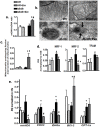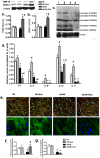Short term exercise induces PGC-1α, ameliorates inflammation and increases mitochondrial membrane proteins but fails to increase respiratory enzymes in aging diabetic hearts
- PMID: 23936397
- PMCID: PMC3731348
- DOI: 10.1371/journal.pone.0070248
Short term exercise induces PGC-1α, ameliorates inflammation and increases mitochondrial membrane proteins but fails to increase respiratory enzymes in aging diabetic hearts
Abstract
PGC-1α, a transcriptional coactivator, controls inflammation and mitochondrial gene expression in insulin-sensitive tissues following exercise intervention. However, attributing such effects to PGC-1α is counfounded by exercise-induced fluctuations in blood glucose, insulin or bodyweight in diabetic patients. The goal of this study was to investigate the role of PGC-1α on inflammation and mitochondrial protein expressions in aging db/db mice hearts, independent of changes in glycemic parameters. In 8-month-old db/db mice hearts with diabetes lasting over 22 weeks, short-term, moderate-intensity exercise upregulated PGC-1α without altering body weight or glycemic parameters. Nonetheless, such a regimen lowered both cardiac (macrophage infiltration, iNOS and TNFα) and systemic (circulating chemokines and cytokines) inflammation. Curiously, such an anti-inflammatory effect was also linked to attenuated expression of downstream transcription factors of PGC-1α such as NRF-1 and several respiratory genes. Such mismatch between PGC-1α and its downstream targets was associated with elevated mitochondrial membrane proteins like Tom70 but a concurrent reduction in oxidative phosphorylation protein expressions in exercised db/db hearts. As mitochondrial oxidative stress was predominant in these hearts, in support of our in vivo data, increasing concentrations of H2O2 dose-dependently increased PGC-1α expression while inhibiting expression of inflammatory genes and downstream transcription factors in H9c2 cardiomyocytes in vitro. We conclude that short-term exercise-induced oxidative stress may be key in attenuating cardiac inflammatory genes and impairing PGC-1α mediated gene transcription of downstream transcription factors in type 2 diabetic hearts at an advanced age.
Conflict of interest statement
Figures









References
-
- Public Health Agency of Canada (2011) Diabetes in Canada: Facts and figures from a public health perspective.
-
- Mootha VK, Lindgren CM, Eriksson KF, Subramanian A, Sihag S, et al. (2003) PGC-1alpha-responsive genes involved in oxidative phosphorylation are coordinately downregulated in human diabetes. Nat Genet 34: 267–273. - PubMed
Publication types
MeSH terms
Substances
Grants and funding
LinkOut - more resources
Full Text Sources
Other Literature Sources
Medical
Molecular Biology Databases
Research Materials
Miscellaneous

